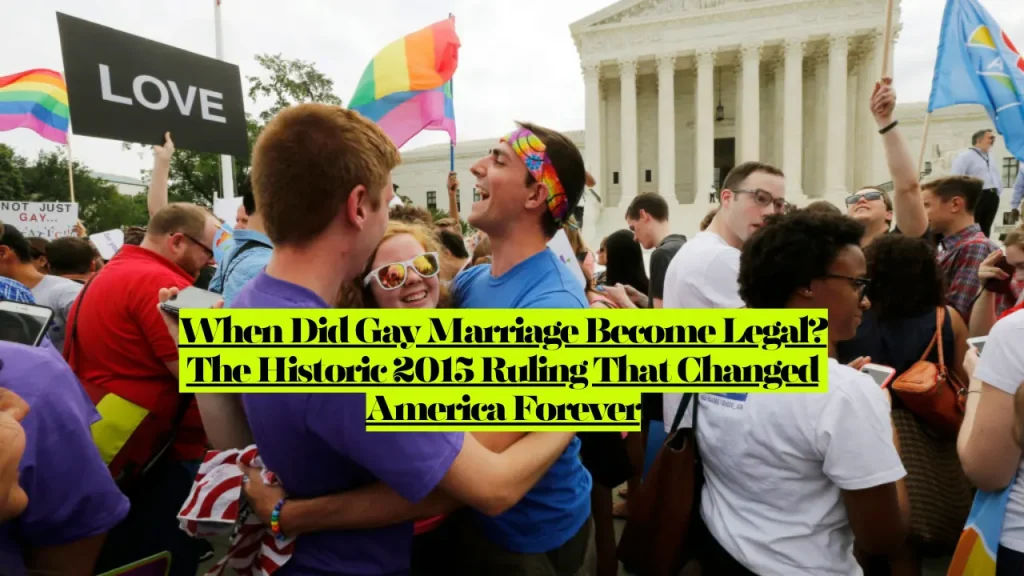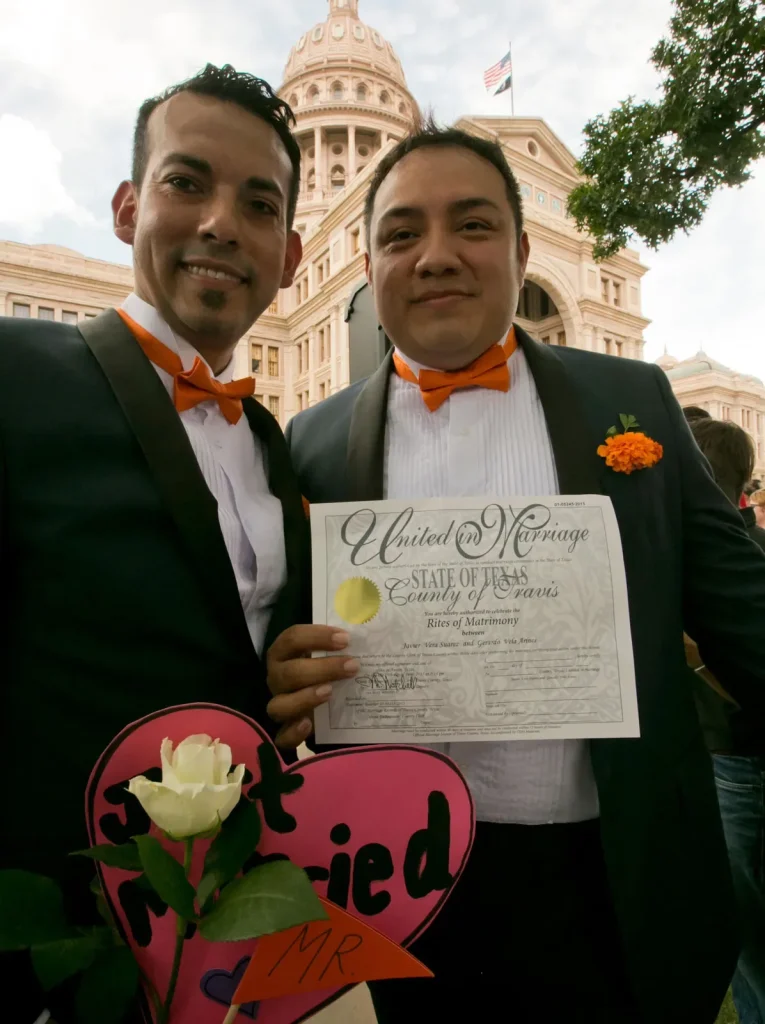When Did Gay Marriage Become Legal? The Historic 2015 Ruling That Changed America Forever
Legal Disclaimer: This information is for educational purposes only and does not constitute legal advice. Consult a qualified attorney for guidance on specific legal matters.
Gay marriage became legal nationwide on June 26, 2015, when the U.S. Supreme Court ruled 5-4 in Obergefell v. Hodges that the Fourteenth Amendment requires all states to grant same-sex marriages and recognize same-sex marriages granted in other states. This landmark decision ended decades of legal battles and made marriage equality the law of the land across all 50 states.
The case bore the name of Jim Obergefell, an Ohio man who fought to be listed as the surviving spouse on his dying husband John Arthur’s death certificate. Their love story, which began at a Cincinnati bar in the early 1990s, would ultimately reshape American family law and secure constitutional protections for millions of same-sex couples.
When Did Gay Marriage Become Legal Nationwide?
On June 26, 2015, Justice Anthony Kennedy delivered the opinion of the Court, joined by Justices Ginsburg, Breyer, Sotomayor, and Kagan, declaring that same-sex couples have a fundamental right to marry under both the Due Process Clause and the Equal Protection Clause of the Fourteenth Amendment.
The ruling was momentous. The Court concluded that denying same-sex couples access to marriage violates the Equal Protection Clause of the Constitution. States that had banned same-sex marriage through statutes or constitutional amendments were immediately required to issue marriage licenses to same-sex couples and recognize all valid same-sex marriages performed elsewhere.
Before this decision, thirty-six states and the District of Columbia permitted same-sex marriage, creating a patchwork of rights that varied dramatically depending on where a couple lived. The Supreme Court’s ruling eliminated this confusion and extended marriage equality to every corner of the nation.
What Was Obergefell v. Hodges?
Obergefell v. Hodges is a landmark decision of the United States Supreme Court which ruled that the fundamental right to marry is guaranteed to same-sex couples by both the Due Process Clause and the Equal Protection Clause of the Fourteenth Amendment.
The case actually consolidated four separate lawsuits from Michigan, Ohio, Kentucky, and Tennessee. The petitioners, 14 same-sex couples and two men whose same-sex partners were deceased, filed suits in Federal District Courts in their home States, claiming that respondent state officials violate the Fourteenth Amendment by denying them the right to marry.

The Heartbreaking Story Behind the Case
Jim Obergefell met John Arthur in the early 1990s at Uncle Woody’s Bar near the University of Cincinnati. They built a life together, working in IT consulting and sharing dreams of growing old side by side.
In 2011, Arthur was diagnosed with ALS (Lou Gehrig’s disease) at age 46. By 2013, he was bedridden and paralyzed, with his death imminent. On June 26, 2013—exactly two years before the Supreme Court would legalize gay marriage nationwide—the couple learned that the Court had struck down a key part of the Defense of Marriage Act (DOMA).
Obergefell proposed to Arthur, and family and friends raised $14,000 to charter a medical jet so the couple could marry in Maryland, where same-sex marriage was legal. On July 11, 2013, they were married on the tarmac at Baltimore-Washington International Airport with Arthur’s aunt officiating the ceremony.
When they returned to Ohio, they learned that Jim would not be listed on John’s death certificate as his surviving spouse because Ohio did not recognize their marriage. This injustice sparked their legal fight. Arthur died in October 2013, but Obergefell continued the battle all the way to the Supreme Court.
The Supreme Court’s Legal Reasoning
Justice Kennedy’s majority opinion established four fundamental principles explaining why marriage is a constitutional right that must extend to same-sex couples:
1. Individual Autonomy
The Court held that decisions concerning marriage are among the most intimate that an individual can make, protected by the concept of individual autonomy inherent in personal choice regarding marriage.
2. Unique Two-Person Union
The right to marry is fundamental because it supports a two-person union unlike any other in its importance to the committed individuals, responding to the universal fear that a lonely person might call out only to find no one there.
3. Protection of Children and Families
Marriage safeguards children and families, providing stability and legal recognition essential to family life.
4. Foundation of Social Order
Marriage remains a keystone of social order, and excluding same-sex couples from this institution demeans their existence.
Justice Kennedy concluded that “the reasons marriage is fundamental under the Constitution apply with equal force to same-sex couples.”
What the Ruling Meant for States
The Court held that same-sex couples are entitled to marry “on the same terms and conditions as opposite-sex couples” and that states must recognize such marriages performed in other jurisdictions.
The ruling not only gave same-sex couples the right to marry nationwide but also extended related marital benefits, including adoption rights, access to health care, inheritance, taxation, spousal benefits under Social Security, and recognition as next of kin for medical decisions.
Which States Legalized Same-Sex Marriage Before 2015?
The path to nationwide marriage equality was gradual, with pioneering states leading the way years before the Supreme Court acted.
Massachusetts: The First State
On May 17, 2004, Massachusetts became the first U.S. state and the sixth jurisdiction in the world to legalize same-sex marriage following the Supreme Judicial Court’s decision in Goodridge v. Department of Public Health.
Just after midnight on May 17, 2004, same-sex couples began filling out marriage license applications at Cambridge City Hall. This historic moment came after the Massachusetts Supreme Judicial Court ruled on November 18, 2003, that denying marriage rights to same-sex couples violated the Massachusetts Constitution.
The State-by-State Progression
Connecticut became the third state to authorize same-sex couples to marry on November 12, 2008. Other early adopters included:
- Vermont (2009): Adopted civil unions in 2000, then full marriage equality
- Iowa (2009): Through a state Supreme Court decision
- New Hampshire (2010): Via legislative action
- New York (2011): Legalized through the Marriage Equality Act
- Washington (2012): Approved by voter referendum
- Maryland (2012): Approved by voter referendum
- Maine (2012): Approved by voter referendum
Between January 2012 and February 2014, plaintiffs in Michigan, Ohio, Kentucky, and Tennessee filed federal district court cases that culminated in Obergefell. By the time the Supreme Court ruled in 2015, thirty-six states and the District of Columbia permitted same-sex marriage, and public opinion had shifted to majority support.
Key Legal Milestones Leading to Marriage Equality
The road to Obergefell was paved with crucial legal victories that built momentum for nationwide recognition.
Defense of Marriage Act (1996)
Congress responded with the Defense of Marriage Act (DOMA) in 1996, limiting federal recognition of marriage to opposite-sex couples. This law created two key barriers: Section 2 allowed states to refuse recognition of same-sex marriages from other states, while Section 3 defined marriage for federal purposes as between one man and one woman.
Lawrence v. Texas (2003)
In 2003, the Supreme Court overruled its 1986 decision in Bowers v. Hardwick, which upheld a Georgia law that criminalized certain homosexual acts, concluding laws making same-sex intimacy a crime “demean the lives of homosexual persons.” This decision, also written by Justice Kennedy, laid groundwork for future marriage equality arguments.
United States v. Windsor (2013)
The Obergefell v. Hodges decision came on the second anniversary of the United States v. Windsor ruling that struck down Section 3 of DOMA as being unconstitutional. Windsor required the federal government to recognize same-sex marriages valid under state law, but left Section 2 intact and didn’t mandate that all states legalize same-sex marriage.
Hollingsworth v. Perry (2013)
This case challenged California’s Proposition 8, which had banned same-sex marriage after it was briefly legal. While the Supreme Court dismissed the case on procedural grounds, the decision allowed same-sex marriage to resume in California.
What Changed After the 2015 Ruling?
The Obergefell decision transformed American society in profound ways:
Federal Benefits Recognition
Same-sex married couples gained immediate access to over 1,000 federal benefits previously denied, including Social Security survivor benefits, veterans’ benefits, and favorable tax treatment.
Adoption and Parental Rights
Same-sex couples gained adoption rights and parental recognition across all states, eliminating the need for second-parent adoptions in many jurisdictions.
Healthcare and Medical Decision-Making
The decision indirectly affects the health of many LGBT persons by expanding federal and state health-related benefits, including spousal health insurance coverage and recognition as next of kin for medical decisions.
Immigration Rights
Same-sex married couples gained the same immigration sponsorship rights as opposite-sex couples, allowing American citizens to sponsor their foreign spouses for green cards.
Elimination of Legal Uncertainty
The patchwork of state laws that created confusion when couples traveled or relocated was eliminated, providing consistent protection nationwide.
Current Legal Status and Ongoing Challenges
While Obergefell remains the law of the land, marriage equality faces ongoing legal and political challenges.
The Respect for Marriage Act (2022)
The 2022 Respect for Marriage Act provides federal recognition for same-sex marriages and prohibits states from discriminating against same-sex couples in situations involving state-to-state recognition. However, the RFMA does not mandate that states perform same-sex marriages if Obergefell were overturned—it only requires recognition of marriages validly performed elsewhere.
Supreme Court Scrutiny
In his concurrence overturning Roe v. Wade in 2022, Justice Thomas wrote, “In future cases, we should reconsider all of this Court’s substantive due process precedents, including Griswold, Lawrence, and Obergefell.” This statement has raised concerns about the durability of marriage equality protections.
While a strong majority of Americans favor equal marriage rights, support appears to have softened in recent years—70% of Americans supported same-sex marriages in 2024, though that level has plateaued since 2020.
Kim Davis Case Consideration
In November 2024, Supreme Court justices debated whether to take on a legal challenge brought by former Kentucky county clerk Kim Davis, who refused to issue marriage licenses to same-sex couples in 2015. While this case could have implications for religious liberty claims, legal analysts believe it is more likely the Court might decide the case on narrower grounds rather than directly overrule Obergefell.
Public Support Remains Strong
A Gallup poll from May 2024 found that 69 percent of U.S. adults support legal same-sex marriage—close to the record high of 71 percent. Public support for the freedom to marry has only continued to grow since the Supreme Court’s marriage decision, providing a strong societal foundation for these rights.
The Dissenting Opinions: The Other Side
The Obergefell decision was not unanimous. Chief Justice Roberts and Justices Scalia, Thomas, and Alito each authored dissenting opinions.
Chief Justice Roberts wrote: “The fundamental right to marry does not include a right to make a State change its definition of marriage. The people of a State are free to expand marriage to include same-sex couples, or to retain the historic definition.”
The dissenters argued that while many Americans would celebrate the decision, it represented judicial overreach that removed the issue from democratic debate. They contended that marriage definitions should be determined by state legislatures and voters, not federal courts interpreting the Constitution.

How Obergefell Compares to Other Civil Rights Rulings
This historic case has been widely hailed as the Brown v. Board of Education of the gay rights movement, joining a lineage of Supreme Court decisions that expanded civil rights and equal protection.
Obergefell is among the privacy line of cases the Supreme Court has decided since the 1960s, including Griswold v. Connecticut (1965), Loving v. Virginia (1968), Roe v. Wade (1973), and Lawrence v. Texas (2003).
The majority opinion explicitly tied marriage equality to these precedents, emphasizing that fundamental rights evolve as understanding of liberty and equality deepens.
Global Context: Marriage Equality Worldwide
The United States became the 23rd country to recognize marriage equality when Obergefell was decided. As of 2025, marriage between same-sex couples is legally performed and recognized in 38 countries, with a total population of 1.5 billion people (20% of the world’s population).
The most recent jurisdictions to legalize same-sex marriage include Thailand (2024) and Czechia (2025, civil unions). The global trend continues toward greater recognition, though some countries have enacted preventative constitutional bans, with the most recent being Mali in 2023 and Gabon in 2024.
Frequently Asked Questions About When Gay Marriage Became Legal
When exactly did gay marriage become legal in the United States?
Gay marriage became legal nationwide on June 26, 2015, when the U.S. Supreme Court ruled in Obergefell v. Hodges. The decision took effect immediately, requiring all states to issue marriage licenses to same-sex couples and recognize valid same-sex marriages performed elsewhere.
What was the Supreme Court vote on gay marriage?
The United States Supreme Court held in a 5-4 decision that same-sex marriage is protected under the Due Process and Equal Protection Clauses of the Fourteenth Amendment. Justice Kennedy wrote the majority opinion, joined by Justices Ginsburg, Breyer, Sotomayor, and Kagan.
Which state was the first to legalize same-sex marriage?
Massachusetts became the first U.S. state to legalize same-sex marriage on May 17, 2004, following the Supreme Judicial Court’s decision in Goodridge v. Department of Public Health. Couples began obtaining marriage licenses immediately after midnight on that date.
How many states allowed gay marriage before the Supreme Court ruling?
By 2015, thirty-six states and the District of Columbia permitted same-sex marriage through various means including court rulings, legislative action, and voter referendums. Fourteen states still banned same-sex marriage when Obergefell was decided.
Can same-sex marriage be overturned?
While there are concerns about potential challenges, the doctrine of stare decisis—which means courts generally respect and follow their own prior rulings—is strong, and the Supreme Court rarely overturns an important constitutional ruling so soon after issuing it. Additionally, even if the Supreme Court were to reverse its marriage equality decision, that would not invalidate existing marriages or change anything in the many states that have adopted the freedom to marry under state law.
What protections exist if Obergefell is challenged?
The 2022 Respect for Marriage Act provides federal recognition for same-sex marriages and requires states to recognize valid marriages performed in other states. This provides an additional layer of protection beyond the constitutional ruling.
How did the Defense of Marriage Act affect same-sex couples?
Congress passed DOMA in 1996, limiting federal recognition of marriage to opposite-sex couples. The law prevented same-sex married couples from accessing over 1,000 federal benefits. In United States v. Windsor (2013), the Supreme Court invalidated Section 3 of DOMA, requiring federal recognition of same-sex marriages valid under state law.
Related Articles You Might Find Helpful
To better understand your rights and legal options related to family law and marriage, you may find these resources helpful:
- LGBT Divorce Attorney: Your Essential Guide to Experienced Same-Sex Divorce Lawyers
- Questions to Ask a Divorce Lawyer During Consultation
- Questions to Ask a Custody Lawyer During Consultation
The Road Ahead: Protecting Marriage Equality
Given the uncertain legal landscape with policy initiatives and shifting judicial perspectives, comprehensive legal planning isn’t just prudent—it’s essential for protecting LGBTQ families and their assets.
Same-sex couples should consider:
- Creating or updating wills to explicitly include spouses and children
- Establishing healthcare and financial powers of attorney
- Creating advance directives specifying medical preferences
- Consulting experienced family law attorneys about estate planning
- Documenting parental relationships through adoption when possible
The Bottom Line
When did gay marriage become legal? On June 26, 2015, the Supreme Court’s Obergefell v. Hodges decision made marriage equality the law of the land. This landmark ruling, born from Jim Obergefell’s fight to honor his dying husband, transformed American family law and secured constitutional protections for millions of loving couples.
The decision reshaped family law, property, insurance, and business regulation across the United States, extending fundamental rights and dignity to same-sex couples nationwide. While challenges remain, the legacy of Obergefell continues to affirm that love, commitment, and family deserve equal recognition under the law.
Need Legal Guidance? If you have questions about marriage rights, family law, or estate planning as an LGBTQ+ individual or couple, consult with a qualified attorney who specializes in these areas. The information in this article provides general education about the history of marriage equality but should not be used as a substitute for personalized legal advice.
About the Author

Sarah Klein, JD, is a former family law attorney with over a decade of courtroom and mediation experience. She has represented clients in divorce, custody cases, adoption, Alimony, and domestic violence cases across multiple U.S. jurisdictions.
At All About Lawyer, Sarah now uses her deep legal background to create easy-to-understand guides that help families navigate the legal system with clarity and confidence.
Every article is based on her real-world legal experience and reviewed to reflect current laws.
Read more about Sarah
